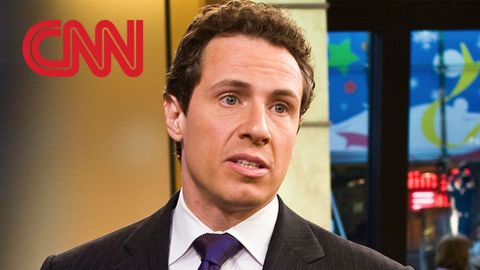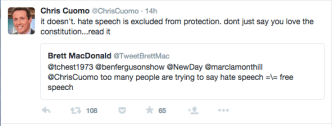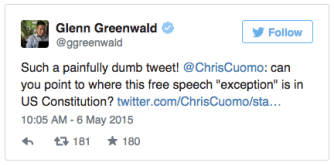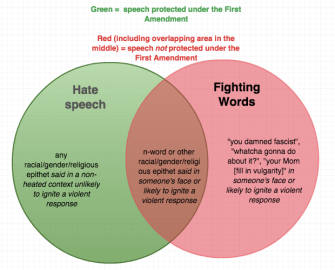Chris Cuomo Won’t Walk Back His Ignorant Tweet About Hate Speech

Chris Cuomo, a CNN anchor and the brother of New York’s governor, Andrew Cuomo, performed a valuable public service on Wednesday when he sent what I would hope is the most ignorant tweet of his Twitter career. Here it is, followed by the tweet he was responding to:

Chris Cuomo is a law-school graduate. He was once the chief law and justice correspondent for ABC News. He is a host of a show on a network that bills itself as “the most trusted name in news.” Given all that, he really ought to know better.
“Hate speech” is expression that demeans an individual or a group based on identity markers like race, religion, ethnicity, gender, or sexual orientation. As distasteful as this type of communication might be, the American judiciary has consistently held it to be protected by the First Amendment’s requirement that “Congress [and, through the 14th amendment, states and local governments] shall make no law … abridging the freedom of speech.” As Garrett Epps of the Baltimore School of Law and The Atlantic put it in a tweet, in the eyes of the Constitution, “hate speech is just speech.”
Cuomo’s tweet, and his stubborn campaign to defend it in the wake of a merciless assault from the Twitterverse, errs in two ways. First, it’s ludicrous to state that “reading” the Constitution will reveal that hate speech is “excluded from protection.” There is no such language anywhere in the Constitution. Cuomo’s arrogant ignorance provoked an equal and opposite reaction. Here are two choice responses:


But this bonehead error is actually less egregious than the deeper mistake in Cuomo’s tweet — a flub that Cuomo tried to deflect by clarifying what he meant by “read the Constitution.” Here was his move:

In contrast to Horton the Elephant, Cuomo didn’t mean what he tweeted or tweet what he meant. He meant to say, “Read the case law.” OK. If you read the case law, you will find a case called Chaplinsky v. New Hampshire where the Supreme Court held, in 1942, that so-called “fighting words” — words that “inflict injury or tend to incite an immediate breach of the peace” — do not enjoy First Amendment protection. Fine.
Not fine.
By using “Chaplinsky” as a mantra in responding to dozens of critical tweets on Wednesday afternoon, Cuomo dug himself a deeper hole. Here’s why: Chaplinsky says nothing — nothing — about hate speech per se. It says only that taunts issued face to face that could provoke a violent reaction are eligible to be banned or punished by the state. So when Walter Chaplinsky called the town marshal in Rochester, New Hampshire, a “God-damned racketeer” and a “damned fascist,” it was fine for the town to arrest him under the state’s “offensive conduct” law. Note the term “conduct”: John Stuart Mill argued that speech should only be open to state regulation when it crosses the boundary into action or when, as the Supreme Court held in 1969, it is “brigaded with action.” Mere offensive speech, however hateful, gets protection under the First Amendment umbrella. But when speech is likely to incite imminent lawless action or spur someone to take the first swing in a barroom brawl, it is curtailable.
In the midst of the Twitter war he set off, Cuomo refused to back down. He kept insisting, in tweet after tweet, that he only meant to say that fighting words, supposedly a subset of hate speech, are excluded from constitutional protection. But his thinking is muddled. Some hate speech might count as fighting words: Call an African-American the n-word or a Jew the k-word to his face, in the heat of a dispute, and you can expect punches to fly.
Yet say the same words in private, or on the Internet, or in a calmer context, and your expression gets First Amendment cover. In fact, there are plenty of hateful things you might publish or announce about gays, women, Catholics, or Mexicans that do not constitute fighting words because those things are not said, as the expression goes, right up in someone’s grill. Likewise, there are endless opportunities to set off a fight without demeaning somebody’s identity. Here’s an example I tweeted to Cuomo:

What we have here is a tragic misunderstanding of Venn diagrams. Cuomo construes “fighting words” as a wholly owned subsidiary of “hate speech.” Not so. The categories are overlapping. Let me illustrate:

createlyPlayerStart( {
container: "creately-container-i9do2js8-WvuUDBAkdqM7qIgGe6uYpnHsirw=",
docid :"i9do2js8-WvuUDBAkdqM7qIgGe6uYpnHsirw=",
title :"Cuomo",
width :600,height :400,bgcolor :"#eeeeee"
} );
// ]]>
This is a fancy way of showing that Cuomo was wrong in his initial tweet and dead wrong in his pivot to Chaplinsky as a refinement of his initial contention. The Constitutional protection of free speech has an exception for expression that spurs violence, and certain forms of hate speech may qualify as violence-igniting. But the Constitution simply does not allow (partial or complete) bans on hate speech, per se.
As I wrote at the top of the post, Cuomo’s errors represent a valuable public service. They are the perfect teachable moment: an opportunity to explain what free speech in the United States is really about, and how even educated people can easily get confused. It’s also a lesson in how not to respond when you make a mistake.
Image credit: Shutterstock





